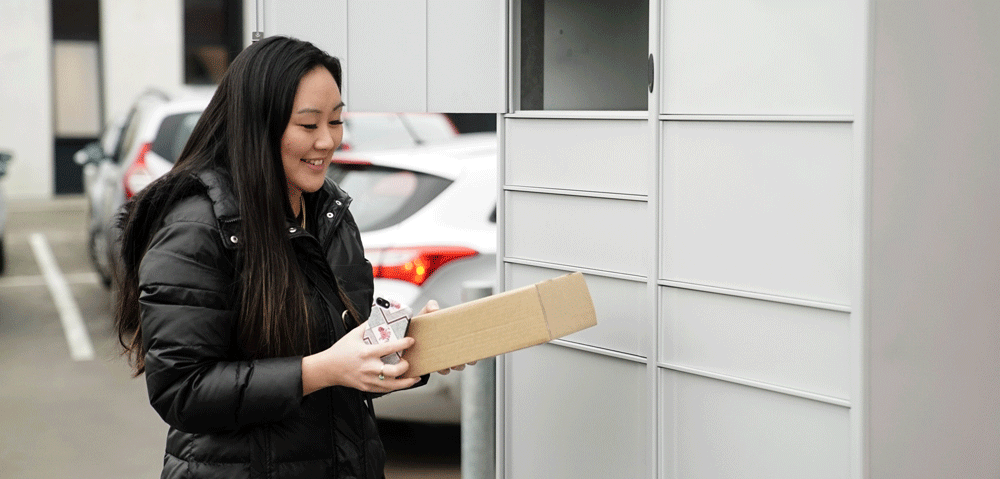China’s e-commerce sector is booming. Next-day and same-day delivery are the norm, and parcel lockers are crucial in delivering parcels. Juan Sotolongo (722 Consulting), Ian Kerr (Postal Hub Podcast) and Marek Różycki (Last Mile Experts) analyze the market
Chinese philosopher Confucius said, “For last-mile delivery, use parcel lockers!” Okay, that might not have been Confucius, but they’re wise words nonetheless.
Huge express sector
China’s express delivery sector handled around 50 billion parcels in 2018. That’s 10 times as many as global giant UPS. Last year’s Singles Day generated 1.88 billion parcels – dwarfing the 175 million items sold during this year’s Amazon Prime Day.
The express delivery sector supports annual e-commerce sales of nearly 6.9 trillion Yuan (US$1tn), which is over 19% of China’s retail sales.
China developed the out-of-home delivery network because it had no choice. E-commerce parcel volumes were growing in 2018 at 40-50% per annum (now ‘only’ 30% per year), so at that scale last-mile out-of-home solutions had to be developed quickly.
Parcel lockers at unimaginable scale
Parcel lockers are ubiquitous in China. Hive Box has 150,000 locker locations, China Post has 100,000, JD.com has 50,000 and Cainiao has 10,000 locker locations. That’s a total of 310,000 locker installations. This puts even the largest European or North American networks in the shade, the most expansive of which have in the region of 5,000 lockers.
All these parcel lockers (with the exception of JD) are open networks – even China Post’s network. This is particularly farsighted and deserves kudos for the Chinese players.
The scale of online shopping in China makes parcel lockers indispensable and omnipresent. Online shopping is so prominent in China that it’s an everyday thing.
Chinese urban culture is busy – everyone’s working, so they shop online. As experienced online shoppers, they know their delivery options. Huge numbers of people use their work address as their delivery address. This has the advantage of meaning that even if the recipient isn’t there, the workplace will accept the package. This contrasts with the Western world, where few lockers are present, and a growing number of companies refuse to accept parcel delivery due to security concerns or simply the time and cost of managing the growing volume of parcels for employees.
In China, receiving employees’ parcels isn’t a big deal at small workplaces, but in office buildings, courier drivers aren’t allowed past reception. This brings us to the other key enabler of e-commerce delivery: the mobile phone.
Drivers know their patches, so when they get to an office building, they will call the consumer. Phone calls are crucial to the last mile – forget about apps and customer push notifications. The courier driver calls the recipient to say, “I’m here, come and collect your parcel.” The recipient then either meets the courier to collect the parcel or asks the courier to put the parcel in a nearby parcel locker. For customers who don’t answer the phone call, the consignment will be delivered to a nearby parcel locker.
For residential deliveries, if there’s no local parcel locker, the customer might ask the courier to leave the parcel at the front door or with a neighbor. Alternatively, if the customer is not at home but in the vicinity, they might say, “Bring it to me where I am.” There will be an additional charge for this, and this fee goes directly to the driver, not to the courier company.
The phone is critical because it is real time – it puts pressure on the customer to decide. There’s also a cultural aspect: in some countries people won’t answer their phone if they don’t recognize the caller ID. In China, people will answer the phone regardless.
PUDOs and parcel shops
In China, PUDO networks exist, but they’re not used as much as parcel lockers. When you consider China’s density of parcel lockers, and the potential volumes involved, PUDOs are a second-best solution. A parcel shop couldn’t deal with the volumes that parcel lockers handle, and parcel lockers are accessible 24 hours a day.
In Europe, PUDOs are critical because even the largest APM networks are unable to service all parcel volumes, especially at peak, and the lack of open networks means that finding enough locations can be a challenge.
Returns and the first mile
Parcel lockers enable the first mile and e-commerce returns. For returns, as with most lockers, the customer scans a barcode and a locker door opens.
The first-mile experience via lockers is carrier agnostic, and customers can choose whichever carrier they please. Payment is made at the machine or via a digital payment platform such as AliPay. This offers convenience and proximity that isn’t available in most European or North American (closed) networks.
A signpost for the West
China’s embrace of carrier-agnostic parcel lockers provides a guide for the future of parcel delivery in the West. Delivery costs are very low but service is fast and high quality. Interactive delivery management in the form of push notifications from carriers on customers’ smartphones may take the place of the courier phone call in Western countries because of labor costs and cultural differences.
In China, next-day and same-day delivery are considered the norm in large cities – and parcel lockers play a crucial role in keeping the delivery chain moving.
Bios
 Juan Sotolongo is senior partner and founder at 722 Consulting, a consultancy focusing on productivity and efficiency in parcels, logistics and the field services sectors.
Juan Sotolongo is senior partner and founder at 722 Consulting, a consultancy focusing on productivity and efficiency in parcels, logistics and the field services sectors.

Ian Kerr is the founder and host of the Postal Hub Podcast, the weekly podcast for the postal and delivery sectors.

Marek Różycki is managing partner at Last Mile Experts, specializing in CEP and e-commerce last-mile advisory.
![]()


